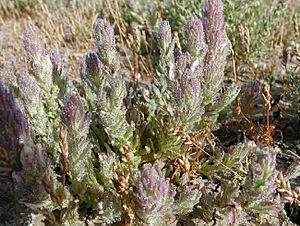Chloropyron facts for kids
Quick facts for kids Chloropyron |
|
|---|---|
 |
|
| Chloropyron palmatum at Delevan National Wildlife Refuge, California, USA | |
| Scientific classification |
|
| Kingdom: | Plantae |
| Clade: | Tracheophytes |
| Clade: | Angiosperms |
| Clade: | Eudicots |
| Clade: | Asterids |
| Order: | Lamiales |
| Family: | Orobanchaceae |
| Tribe: | Pedicularideae |
| Subtribe: | Castillejinae |
| Genus: | Chloropyron Behr |
| Synonyms | |
Chloropyron is a group of plants, also known as a genus, that belongs to the Orobanchaceae plant family. These plants were once part of another group called Cordylanthus. But in 2009, scientists David C. Tank, John Mark Egger, and Richard G. Olmstead studied their DNA. They found that Chloropyron plants were different enough to be their own genus.
Contents
Understanding Plant Names
Plants are given scientific names to help scientists around the world know exactly which plant they are talking about. This system helps keep things organized. Sometimes, names change as we learn more about plants.
How Chloropyron Got Its Name
The genus Chloropyron was first described in 1855 by a German-American scientist named Hans Hermann Behr. He lived in San Francisco. For a long time, other scientists didn't use his name. Instead, they put these plants into the genus Cordylanthus.
Later, in 1867, another scientist named Asa Gray created a smaller group within Cordylanthus. He called this group Hemistegia.
The first plant in this group to be officially described was Chloropyron maritimum. A botanist named Thomas Nuttall first wrote about it. But his work was not published, so it wasn't an official name yet. George Bentham later made the name official in 1846.
Changes in Plant Classification
In 1891, three different plant experts, Edward Lee Greene, Richard Wettstein, and Otto Kuntze, noticed something important. They realized that an older name, Adenostegia, should have been used first. This is called the Principle of Priority. So, they suggested moving all Cordylanthus species to the Adenostegia name.
Richard Wettstein continued to use Asa Gray's Hemistegia group. He saw it as a section within Adenostegia. He recognized three species in this section. He also noticed that some plants had four stamens (parts of a flower) and others had only two.
Keeping Names Stable
In 1905, a big meeting called the International Botanical Congress happened in Vienna. They created rules for naming plants, called the International Code of Botanical Nomenclature (ICBN). They decided that some names, even if they weren't the oldest, should be kept. This helps keep plant names stable and avoids confusion. So, even though Cordylanthus was a newer name than Adenostegia, it was decided to keep Cordylanthus.
In 1911, a Californian botanist named Willis Linn Jepson decided that the Hemistegia group was important enough to be a subgenus.
Later, in 1918, Roxana Stinchfield Ferris described a new species, Chloropyron palmatum. She named it Adenostegia palmata. But this was quickly corrected by James Francis Macbride the next year. Ferris also changed the name of the subgenus Hemistegia to Chloropyron. She recognized four species in this group.
Over the years, different botanists had different ideas about how many species belonged in this group. For example, in 1951, Francis W. Pennell recognized six species. But in 1957, Herbert Louis Mason reduced this to three species. In 1950, Chloropyron tecopense was described.
What Chloropyron Plants Look Like
These plants are small and grow for only one year. They are called annual herbaceous plants. They are usually green or greenish-grey. Sometimes they have red or purple colors because of special pigments called anthocyanins. The tallest of these plants can grow up to 60 centimeters (about 2 feet) tall.
Where Chloropyron Plants Grow
You can find these plants in the western parts of the United States. This includes California, Nevada, Oregon, and Utah. They also grow in Baja California in Mexico.
How Chloropyron Plants Live
These plants naturally grow in places with salty or alkaline soils. This includes salt flats and salt marshes. They are special because they are hemiparasites. This means they are partly parasitic. They have special roots called haustoria that attach to the roots of other plants. They use these connections to take water and nutrients from their host plants.
Species of Chloropyron

- Chloropyron maritimum (Nutt. ex Benth.) A.Heller
- Chloropyron molle (A.Gray) A.Heller
- Chloropyron palmatum (Ferris) Tank & J.M.Egger
- Chloropyron tecopense (Munz & J.C.Roos) Tank & J.M.Egger

